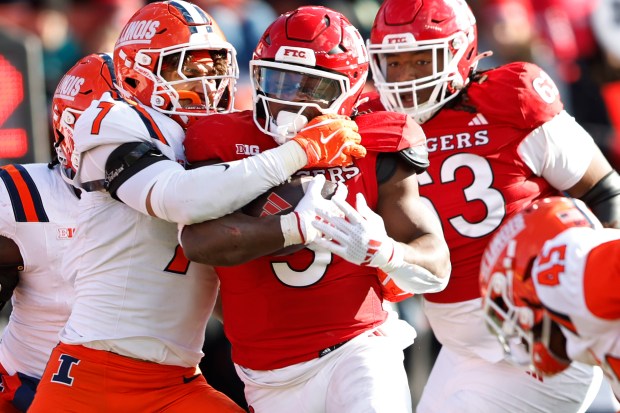If you blinked, you might have missed the review of the Chicago Bears’ addition to their backfield in last weekend’s NFL draft.
The pick was submitted shortly after 5 p.m. Saturday, a Round 7 dice roll on Rutgers running back Kyle Monangai. Less than two hours later, during a recap of all the Bears’ draft activity at Halas Hall, general manager Ryan Poles offered this 43-word scouting thumbnail on the last member of his 2025 draft class.
“Physical, tough runner,” Poles said of Monangai. “High, high, high football and personal character. We believe he can come in and compete. We like his contact balance and, again, just the physical nature of how he plays football. And his pass protection is really good as well.”
That was the celebration. That was the haul. Not quite the exhilaration and grand fulfillment the Bears — and many of their fans — had envisioned when draft week began.
With all due respect to Monangai, who by all accounts is a tough player and a good dude who will bust his tail to squeeze every drop of potential from his NFL journey, this year’s running back class was advertised as one of the deepest and most talented in recent memory. It featured an electric headliner in Boise State’s Ashton Jeanty, plus plenty of proven playmakers to last well into Day 3.
When the draft began Thursday, the running back aisle was fully stocked.
Ohio State’s TreVeyon Henderson, anyone? Iowa’s Kaleb Johnson? Central Florida’s RJ Harvey or Oregon’s Jordan James?
No wonder the eyes of so many talent evaluators and decision makers across the league were wide with anticipation.
Yet the Bears didn’t grab from the running back shelf until Round 7, in the final 50 minutes of a 257-pick draft and after 21 other running backs had been taken.
The Bears were the 21st team to address the position in the draft. (The Cleveland Browns grabbed two: Quinshon Judkins in the second round and Dylan Sampson in the fourth.) And of the 10 teams that didn’t draft a running back, six had either a Pro Bowl performer or a 1,300-yard rusher last season.
But when it came to upgrading their backfield, the Bears didn’t make much of a splash and instead went in the direction their predraft grades told them to.
“Going into the draft, our goal was to really lean on the board,” Poles said Saturday. “We put a lot of time into it. We wanted it to really speak to us. I talked about that over the last two days, not forcing anything for need but really just taking the best guys.”
Change of direction
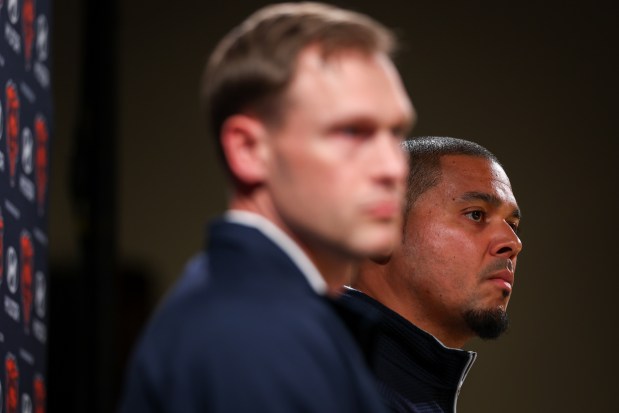
Instead of a running back in Round 2, the Bears wound up first with a wide receiver and then an offensive tackle and a defensive lineman.
The Day 3 positions addressed were linebacker, cornerback and guard. And then, finally, a running back.
Human nature had to trigger some frustration inside the draft room as the running back portion of the draft board seemed to consistently dance away from the Bears like … well, an elusive running back. All weekend long.
Who did the Chicago Bears select in the 2025 NFL draft? Meet the 8-player class.
Inevitably, feelings of deflation and missed opportunity often interrupt the overall excitement of draft weekend.
“Yeah, I’ve always felt that,” Poles acknowledged. “Every draft has pockets that you just don’t fall into. Again, if you’re going to be disciplined, you’re going to let the board dictate how you do things and it just happens that way.”
In this particular draft, the Bears not only asked their board to speak to them, they turned up the volume.
“To Ryan’s credit, he stayed as disciplined as I’ve ever seen in terms of staying true to how we set (the board) up,” Bears coach Ben Johnson said. “Sometimes that gets hard. Sometimes you want to pick for need. But we didn’t necessarily do that.
“I feel really good about the direction we went and every decision we made along the way.”
Left out
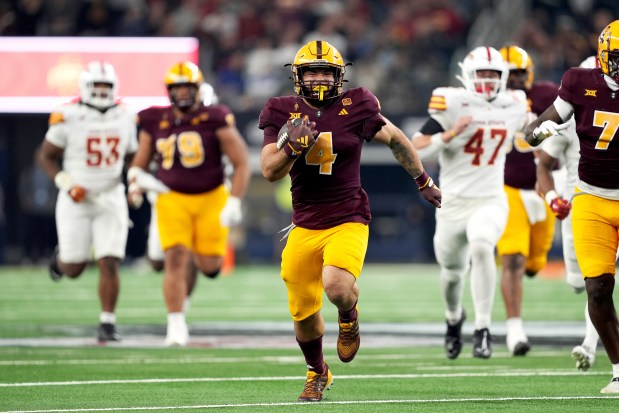
The praise for Monangai in Lake Forest, however, was muted compared with some of the jubilation experienced elsewhere around the league.
In Las Vegas, for example, Jeanty’s arrival had 73-year-old Raiders coach Pete Carroll juiced up and preparing to utilize a playmaker he labeled as “a marvelous talent,” noting Jeanty’s proven “ability to make plays when it doesn’t look like there’s anything there.”
“On any play he can score,” Carroll said. “That’s just such an exciting aspect to add to our football team. We feel very fortunate.”
In New England, where the Patriots drafted Henderson one pick ahead of the Bears in the second round, GM Eliot Wolf shared his excitement about the weapon he snagged.
“His ability to be a threat and make huge plays was something that stood out versus the rest of the class,” Wolf said.
‘A match made in heaven’: How the Chicago Bears settled on ‘Idaho tough’ Colston Loveland at No. 10
Even the New York Giants were doing some fist-pumping and hugging after selecting Arizona State battering ram Cam Skattebo at the start of Round 4.
Giants coach Brian Daboll couldn’t stop listing the traits he fell in love with. Great contact balance. Impressive feet. Tough as nails. Versatile. Good vision. Runs with power.
“One of our favorite players in the draft,” Giants GM Joe Schoen said. “Just the way he plays, the mentality he plays with, the toughness, the competitiveness, the grit. … Just a darn good football player. We were excited to get him.”
The Bears, it should be noted, had interest in all three of those backs, each taken in different pockets across the three days of the draft.
‘It just didn’t make sense’
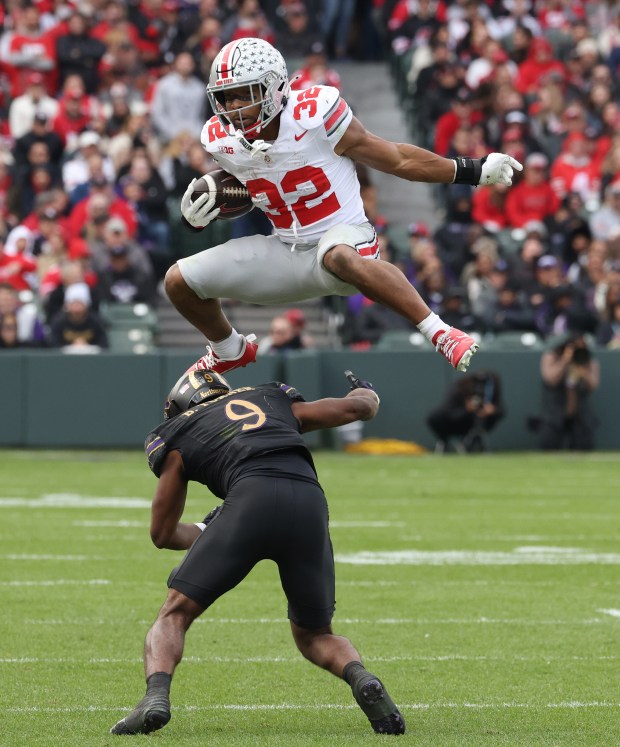
Jeanty was widely considered one of the truly elite prospects of the draft class, regardless of position. And while the Bears made exploratory but purposeful calls to gauge trade-up possibilities, Poles couldn’t justify the price tag for jumping ahead of the Raiders at No. 6, even with the Browns open for business on trades at No. 5.
In all likelihood, the Bears would have had to send the No. 10 pick plus at least one of their original second-round picks to make such a move.
“It just didn’t make sense,” Poles said.
On Friday evening, fingers in the Halas Hall draft room remained crossed that a swing at landing a playmaking running back would connect. Poles pressed the gas and made aggressive attempts to trade up. Henderson’s blend of speed and vision, plus his tenacity in pass protection and skill as a pass catcher, were alluring. The Bears had significant interest.
A deal with the Tennessee Titans at No. 35 felt possible. Until it wasn’t. The Titans found a better offer from the Seattle Seahawks.
Is it possible Ben Johnson and the Chicago Bears have too many toys on offense now?
The Bears’ push to cut one spot in line in front of the Patriots in Round 2 also had momentum. Until it didn’t. At the last minute, New England made its decision at No. 38. Henderson was announced as the newest member of Mike Vrabel’s offense at 6:33 p.m.
“Ultimately we didn’t feel the value that was being offered to us was worth possibly losing out on TreVeyon,” Wolf said. “So we ended up sending the pick in.”
When Saturday began, 14 of the consensus top 20 running back prospects remained available. The belief was the Bears, picking seventh in Round 4, were eyeing a solid opportunity to add a talented back.
Then the Jacksonville Jaguars selected Virginia Tech’s Bhayshul Tuten at No. 104.
Skattebo went to the Giants with the next selection.
You could almost feel a hiss of air deflating out of Halas Hall.
The next steps
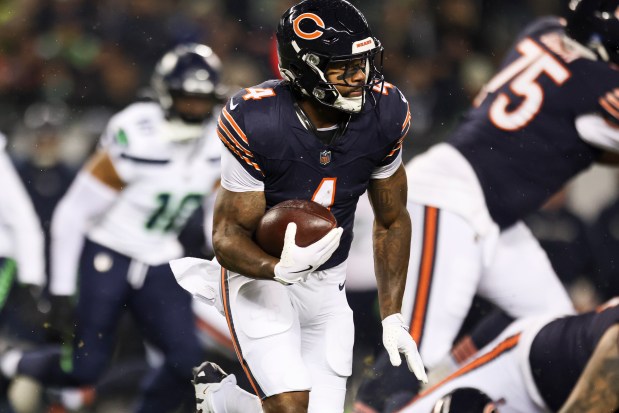
Not long after, the Bears retreated from pick No. 109, trading down 23 spots and again changing their draft wallet, almost certainly because their Saturday morning best-case scenario for the backfield had disintegrated.
Naturally, during that subsequent 23-selection window, a run on running backs occurred: Georgia’s Trevor Etienne to the Carolina Panthers, USC’s Woody Marks to the Houston Texans, Auburn’s Jarquez Hunter to the Los Angeles Rams and Tennessee’s Sampson to the Browns, who already had dipped into the running back pool a day earlier for Ohio State’s Judkins.
As luck would have it, with pick No. 105, the Giants seriously debated internally whether to take Skattebo or Purdue offensive tackle Marcus Mbow. They took the running back — and still snagged Mbow 49 picks later.
What if that debate had been settled differently? How many draft simulations did the Bears perform in which they obtained a more acclaimed back than Monangai?
But as every draft proves, stuff happens. And adjusting is the name of the game.
“You wind up in some really cool situations in acquiring talented players who might come from a different position than you maybe would have liked them to,” Poles said. “But at the end of the day, you’re increasing the talent on your football team. And I do think you can get into a lot of trouble when you start trying to manipulate things to get into certain pockets and it ends up hurting your team long term.”
Column: How Shedeur Sanders’ NFL draft slide saga reflects the state of the nation
So now what? How will the Bears fortify their backfield from here with D’Andre Swift as the starter and Roschon Johnson, Travis Homer, Ian Wheeler and Monangai as the current depth behind him?
Could Poles and Johnson venture back to the free-agency flea market to check in on veteran options such as Nick Chubb, Jamaal Williams, Gus Edwards or Cam Akers?
Or might the Bears choose to push their running back shopping further down the road, trusting Johnson’s offensive vision and creativity to make the best of what’s around?
When the team’s offseason program began earlier this month, there was internal confidence that Swift could be in line for a significant production jump after averaging a career-worst 3.8 yards per carry during his first season with the Bears. The push already has begun for the 26-year-old to become more disciplined with his running style, staying married to the play design and locked into his tracks longer.
The Bears have optimism that Swift’s union with new running backs coach Eric Bieniemy will help him excel in 2025.
Still, the organization’s plans for using the draft to enhance and enliven its backfield were tackled for a loss. That sting should not be understated.
Now comes the task of adjusting, of sounding through possible moves over the coming days and weeks to fashion a response.


